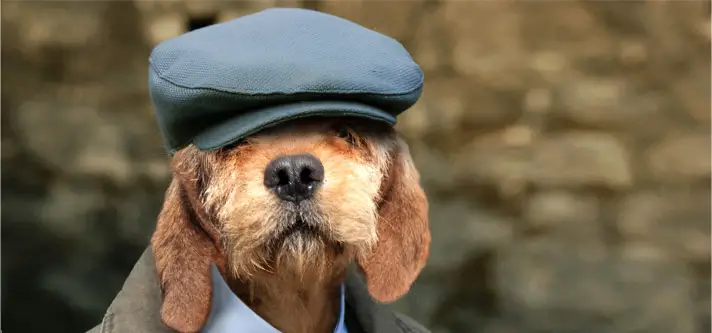When your dog is young and chasing a tennis ball at 100 mph it seems unimaginable that he will age…but he will. And there is a clear difference in caring for an elderly dog as opposed to a younger dog. Most dogs are considered “seniors” at around age eight or nine. This varies depending on breed; larger dogs like Great Danes or Mastiffs usually only live to about eight so six years old is considered elderly. Whereas smaller dogs, like Bichon Frise’s or Poodles can well live to seventeen or eighteen years old so their elderly age would begin at ten or twelve.
If your dog’s golden age is approaching, here are some tips for making you and your dog’s older years as enjoyable as the younger ones.
Veterinary Visits
Most likely when your dog was young you took him to the Vet for shots or ear cleansings about once a year and occasionally for a toy that went missing in his intestines. But when your dog reaches senior age you will most likely need to get there about three-four times a year for anything from ear cleanings, growths/warts, blood work to the ever appealing anal gland release. Older dogs are just like older people – after a long, good life the body needs a bit more attention.
“Elderly care for dogs has become a big part of veterinary practice,” Dr. Anthony Cillis of North County Animal Hospital in Yorktown Heights, New York says, “Dogs are mirroring humans in that they are living longer due to medical innovations and better care.”
While there is no need to bring your older dog to the Vet for no reason, do pay attention to the little things, especially incontinence. Many people wrongly assume incontinence means “the end” and this is not the case; often dogs develop urinary tract infections in increasing numbers as they get older which cause incontinence. This is normally resolved with medication from a vet.
Diet
At around eights year of age it is time to switch your dog to food designated for SENIOR dogs. Senior food contains more vitamins and usually will include glucosamine and chondroitin – mineral supplements that improve joint health in dogs. Nutro Senior, Eukanuba Senior, Nature’s Recipie Senior are just a few of the many brands that use glucosamine and chondroitin in their senior dog food
Also ask your Vet about supplements – there are different types for different ailments. Stephen Schmidt, owner of Petrus, a twelve year old German Shepherd mix says, “”I noticed Petrus was getting stiff climbing the stairs to our fifth-floor walk-up apartment. The Vet suggested glucosamine hydrochloride (500 mg daily) and fish oil supplements (2,000 mg), which I now give him — the pills have made a real difference. He is much more limber and as a bonus the fish oil pills have given him a beautiful shiny coat.”
Exercise
Keeping your older dog in good physical shape is extremely important. Obviously as the dog ages he will want to move around a little less and you will probably find yourself a little more generous with treats. This is not an ideal match as it will result in the dog gaining weight. Weight gain not only causes stress on the heart but puts major stress on joints and that will create pain in mobility. And dogs, no matter what age, must stay mobile. While your dog might not want to walk as much he used to he can at least sit outside and enjoy the sun or passing dogs – keeping your dog involved in activities will give them a sense of purpose.
Be aware of the weather weather; humidity and cold are hard on aging joints – both human and canine. Don’t push your dog if they seem in any type of discomfort especially on a frigid winter day. It sounds obvious but sometimes we think it’s good to push them and have a hard time accepting they can only walk five blocks instead of twenty; the fact is your dog is probably going to want to walk slower and you should accommodate that. On colder days ignore your dog’s possible disdain for a sweater and put it on them. As we get older our blood gets slower and it’s harder to keep the body warm, the same goes for dogs, especially short-haired breeds like Weimaraners or American Staffordshire Terriers.
Grooming
As elderly dogs walk less, the natural process of their nails getting filed down on a hard surface diminishes. Most pet groomers charge $10-20 for nail clipping or you can purchase a clipper and do it yourself. Additionally depending on your dog’s hair summer cuts on long-haired dogs are appropriate in keeping your elderly dogs as comfortable as possible; as they age it is harder to breathe so the less hair on a hot, summer day will make it easier.
If your dog is having problems walking in general both harnesses and dog carts/wheelchairs are available on the internet. Harnesses are ideal for helping dogs upstairs – it is a simple piece of strong material with handles on each side that slips right underneath the chest or back end and allows them to walk with your help.
The Rewards of an Older Dog
Aside from the obvious reward that you won’t have to throw a ball every six minutes for your dog anymore there are other rewards in caring for an elderly pooch. The first being that they are usually a bit calmer – perhaps grumpier – but calmer nonetheless. When you see a large Labrador puppy dragging it’s owner down the street you can look at your well-behaved slow moving pooch and think “Been there, done that, have the ripped up tee shirt.” Your dog is finally fully trained, calmer and you both have established a routine together. All your hard work of training has paid off…enjoy it!
The greatest reward of caring for an older dog is that you have seen them through their entire journey. Whether you adopted them as a puppy or an adult, you have kept your end of the bargain and been a responsible owner throughout. It is not easy to see your dog get old but there is a grand sense of accomplishment in looking at your pooch and thinking that you took care of them for all those years and can proudly say: I did this right.
By Susan Cava

